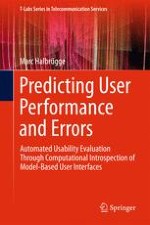2018 | OriginalPaper | Buchkapitel
6. Explaining and Predicting Sequential Error in HCI with Cognitive User Models
verfasst von : Marc Halbrügge
Erschienen in: Predicting User Performance and Errors
Aktivieren Sie unsere intelligente Suche, um passende Fachinhalte oder Patente zu finden.
Wählen Sie Textabschnitte aus um mit Künstlicher Intelligenz passenden Patente zu finden. powered by
Markieren Sie Textabschnitte, um KI-gestützt weitere passende Inhalte zu finden. powered by
Abstract
-
Predict the effectiveness of an interface. Is it error-prone?
-
Prerequisite: A theoretical account of action control and procedural error
-
Implementation as an executable user model in ACT-R (Anderson et al. 2004)
-
Together with the user model, UI meta-information can be used to predict error rates for different UI elements.
